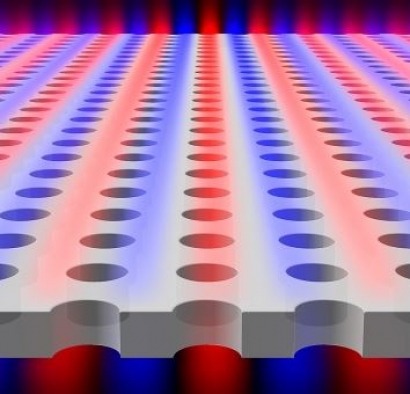
The new system, devised through computer modeling and then demonstrated experimentally, pits light waves against light waves: It sets up two waves that have the same wavelength, but exactly opposite phases — where one wave has a peak, the other has a trough — so that the waves cancel each other out. Meanwhile, light of other wavelengths (or colors) can pass through freely.
The researchers say that this phenomenon could apply to any type of wave: sound waves, radio waves, electrons (whose behavior can be described by wave equations), and even waves in water.
The discovery is reported this week in the journal Nature by professors of physics Marin Soljačić and John Joannopoulos, associate professor of applied mathematics Steven Johnson, and graduate students Chia Wei Hsu, Bo Zhen, Jeongwon Lee and Song-Liang Chua.
“For many optical devices you want to build,” Soljačić says — including lasers, solar cells and fiber optics — “you need a way to confine light.” This has most often been accomplished using mirrors of various kinds, including both traditional mirrors and more advanced dielectric mirrors, as well as exotic photonic crystals and devices that rely on a phenomenon called Anderson localization. In all of these cases, light’s passage is blocked: In physics terminology, there are no “permitted” states for the light to continue on its path, so it is forced into a reflection.
In the new system, however, that is not the case. Instead, light of a particular wavelength is blocked by destructive interference from other waves that are precisely out of phase. “It’s a very different way of confining light,” Soljačić says.
While there may ultimately be practical applications, at this point the team is focused on its discovery of a new, unexpected phenomenon. “New physical phenomena often enable new applications,” Hsu says. Possible applications, he suggests, could include large-area lasers and chemical or biological sensors.
The researchers first saw the possibility of this phenomenon through numerical simulations; the prediction was then verified experimentally.
In mathematical terms, the new phenomenon — where one frequency of light is trapped while other nearby frequencies are not — is an example of an “embedded eigenvalue.” This had been described as a theoretical possibility by the mathematician and computational pioneer John von Neumann in 1929. While physicists have since been interested in the possibility of such an effect, nobody had previously seen this phenomenon in practice, except for special cases involving symmetry.
This work is “very significant, because it represents a new kind of mirror which, in principle, has perfect reflectivity,” says A. Douglas Stone, a professor of physics at Yale University who was not involved in this research. The finding, he says, “is surprising because it was believed that photonic crystal surfaces still obeyed the usual laws of refraction and reflection,” but in this case they do not.
Stone adds, “This is in fact a realization of the famous ‘bound state in the continuum’ proposed by von Neumann and [theoretical physicist and mathematician Eugene] Wigner at the dawn of quantum theory, but in a practical, realizable form. The potential applications the authors mention, to high-power single-mode lasers and to large-area chemical [and] biological sensing, are very intriguing and exciting if they pan out.”
For additional information:

